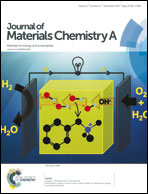Highly-reactive AgPt nanofern composed of {001}-faceted nanopyramidal spikes for enhanced heterogeneous photocatalysis application†
Abstract
The structure and property of the catalyst surface determine the physico-chemical process and the reactivity at the surface, such as catalysis behavior, adsorption, surface segregation and charge transfer, etc. A catalyst with a surface containing high-energy facets, high defect or high-energy sites, such as twinning, vertexes, spikes, etc., may facilitate enhanced catalytic and surface reactivity. Here, we present a straightforward approach to synthesize novel nanopyramidal spike composed nanoferns of AgPt bimetals vertically-oriented on the substrate surface for potential application in catalysis. High-resolution transmission electron microscopy analysis reveals that the nanopyramidal spike is characterized by {001} faces, the high-energy facet of the fcc metal system, promising enhanced catalytic reaction. The crystal growth analysis result determines that the lattice-mismatching effect between Ag and Pt is the key factor for the formation of the nanopyramidal AgPt structure and the nanofern suprastructure is produced via oriented-attachment of the nanopyramidals. The heterogeneous catalytic properties characterisation of AgPt nanofern in the photodegradation of methyl orange in the absence of any reducing agent revealed that the catalytic efficiency is determined by the Ag concentration in the nanocrystals and the morphology of the nanofern structure.


 Please wait while we load your content...
Please wait while we load your content...